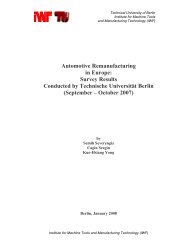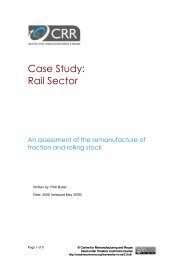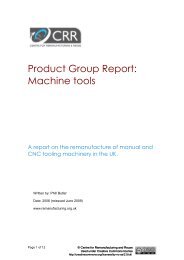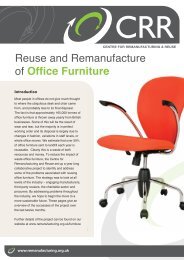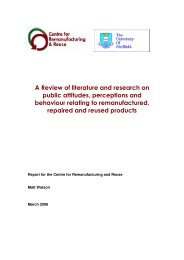Report on the remanufacturing of refrigerated display cabinets
Report on the remanufacturing of refrigerated display cabinets
Report on the remanufacturing of refrigerated display cabinets
You also want an ePaper? Increase the reach of your titles
YUMPU automatically turns print PDFs into web optimized ePapers that Google loves.
©Centre for Remanufacturing & Reuse 2009<br />
Within <strong>the</strong>se organisati<strong>on</strong>s, <strong>the</strong> reputati<strong>on</strong> <strong>of</strong> <strong>the</strong> remanufacturer ensured a<br />
steady flow <strong>of</strong> business. Now, market competitiveness and uncertainty dictates<br />
that <strong>the</strong> buyers default to much shorter planning and buying horiz<strong>on</strong>s. The<br />
volume <strong>of</strong> RDC purchases is also variable and dependent <strong>on</strong> a few key players.<br />
For example, Morris<strong>on</strong>s‟ takeover <strong>of</strong> Safeway led to a significant drop in <strong>the</strong><br />
orders from Safeway; a similar scenario occurred when ASDA was bought by<br />
Wal-Mart.<br />
Whole life costs are not c<strong>on</strong>sidered<br />
Due to <strong>the</strong> purchasing procedures <strong>of</strong> several retailers, <strong>the</strong> tendency to buy new is<br />
reinforced. Yearly budgets and budgets which are focused <strong>on</strong> capital outlay<br />
mean that <strong>the</strong>re is little incentive to purchase <strong>the</strong> most energy efficient cabinet, or<br />
<strong>cabinets</strong> which are suitable for remanufacture. Also, we have seen little evidence<br />
that retailers c<strong>on</strong>sider <strong>the</strong> envir<strong>on</strong>mental c<strong>on</strong>sequences <strong>of</strong> buying new as<br />
opposed to remanufactured RDCs.<br />
Imbalances in fiscal incentives<br />
Financial incentives available for <strong>the</strong> new energy efficient RDCs are not open to<br />
remanufactured units. The Enhanced Capital Allowance (ECA) scheme was set<br />
up to encourage companies, through tax allowances, to choose energy-efficient<br />
plant. This scheme has been criticised by both retailers and manufacturers. The<br />
complexity in applying for ECA means that some retailers are not fully claiming<br />
under <strong>the</strong> scheme, which in turn is a disincentive for <strong>the</strong> manufacturer to apply.<br />
Remanufacturers are also affected. The ECA scheme specifies that “Only<br />
spending <strong>on</strong> new and unused energy-saving equipment can qualify for ECAs” 10<br />
ostensibly making remanufactured units ineligible for <strong>the</strong> scheme. Anecdotally<br />
though, <strong>the</strong>re is some uncertainty over this point and fur<strong>the</strong>r discussi<strong>on</strong> with <strong>the</strong><br />
Department for Energy and Climate Change is necessary. An additi<strong>on</strong>al problem<br />
is that, even if remanufactured RDCs meet <strong>the</strong> envir<strong>on</strong>mental standards,<br />
subjecting individual RDCs to <strong>the</strong> testing criteria will be prohibitive.<br />
10 http://www.eca.gov.uk/etl/about/, accessed <strong>on</strong> 07/05/2009<br />
Page 30 <strong>of</strong> 38





